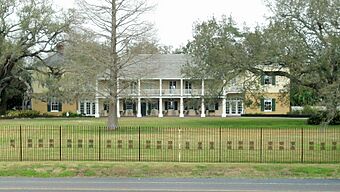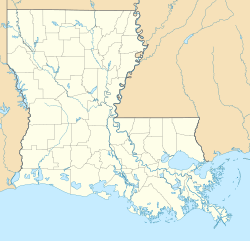Ormond Plantation House facts for kids
Quick facts for kids |
|
|
Ormond Plantation House
|
|

Ormond Plantation House
|
|
| Location | River Rd. (LA 48), Destrehan, Louisiana |
|---|---|
| Built | 1789 |
| Architectural style | French Colonial, West Indies style |
| NRHP reference No. | 90001748 |
| Added to NRHP | November 8, 1990 |
The Ormond Plantation House is a beautiful old home in Destrehan, St. Charles Parish, Louisiana. It was built in the French Colonial style, which was popular in Louisiana long ago. This type of house is also called a Creole plantation house.
The house was built in the late 1700s. It was made using a special method called briquettes entre poteaux. This means "brick between posts." Strong cypress wood posts were used, and bricks were placed between them for the front and back walls. The side walls used a type of adobe material. The front porch, called a veranda or gallery, was held up by round cement and brick columns. Wooden columns supported the roof on the second floor.
Contents
History of Ormond Plantation
Early Owners and Mysterious Events
The first owner and builder of Ormond Plantation was Pierre Trepagnier. He was a sugar farmer who owned many enslaved people. In the early 1780s, he received a large piece of land from the Spanish Governor, Don Bernardo de Galvez. This was a reward for his service as an officer during the American Revolutionary War.
The main house was finished around 1789. Mr. and Mrs. Trepagnier and their eight children lived there. They grew indigo (a plant used for dye) and later sugarcane on the land.
Ormond Plantation has some mysterious stories. One involves Mr. Trepagnier himself. In 1798, a servant called him away from dinner. He was told a coach with a Spanish symbol was outside. The servant saw him meet a man dressed like a Spanish official. When the servant looked again, Mr. Trepagnier, the man, and the coach had all disappeared. They were never seen again.
Colonel Richard Butler and the Name Ormond
On June 25, 1805, Colonel Richard Butler bought the plantation from Trepagnier's widow. Colonel Butler was related to heroes of the American Revolutionary War. He named the house Ormond after his family's old home, the Ormonde Castle in County Tipperary, Ireland.
In August 1809, Butler became business partners with Captain Samuel McCutchon. Captain McCutchon was a merchant and sailor from Pennsylvania who also owned enslaved people.
On June 29, 1819, Colonel Butler gave all his property to Captain McCutchon. Butler and his wife then moved to Bay St. Louis, Mississippi. No one knows for sure why Butler sold the plantation. Some think he was trying to escape a serious illness outbreak called Yellow fever. Sadly, it is believed he still caught the illness and passed away at age 43.
Changes and New Families
There are two separate buildings next to the main house called garconnieres. These were like bachelor quarters. People disagree about when they were built. Some say Richard Butler built them around 1811. Others believe Captain McCutchon built them in 1830. These buildings are taller than the main house and give Ormond Plantation a special look.
Captain McCutchon's oldest son, Samuel B. McCutchon, married Adele d'Estrehan. She was the daughter of the owner of the nearby Destrehan Plantation. This marriage connected two powerful families in the area. Samuel and his brother James William McCutchon took over the plantation after their father died. The plantation continued to do well.
After the American Civil War, the plantation faced hard times. It was sold several times at public auctions. On December 1, 1898, State Senator Basile LaPlace Jr. bought Ormond Plantation. He planned to use it for growing rice. Mr. LaPlace was a well-known public official. Legend says that on October 11, 1899, less than a year after buying Ormond, he died under mysterious circumstances on the property.
After the LaPlace family, the Schexnaydre family bought the plantation. Five Schexnaydre brothers each owned a part of it. Emilien's family lived in the main house, and at one point, five Schexnaydre families lived there. This family owned the property until 1926.
Restoration and Modern Use
In the late 1920s and 1930s, many different people rented the house and land. The home started to fall apart. Then, in 1943, Mr. and Mrs. Alfred Brown bought it. They owned Brown's Velvet Dairy in New Orleans. The Browns started a big project to restore the house. They added modern things like indoor plumbing, natural gas, and electricity.
After Mrs. Brown passed away, Mr. Brown sold Ormond to a real estate developer. In 1974, the developer sold the home and 17 acres of land to Betty R. LeBlanc. Mrs. LeBlanc began restoring the plantation house in the late 1970s and early 1980s. Sadly, she passed away in June 1986 before the renovations were finished.
Present day
Today, Ormond Plantation is listed on the National Register of Historic Places. This means it is an important historical site. It is currently owned by Irvin J. Carmouche. Mr. Carmouche continues to restore the house. He allows the home to be used for public tours. It is also a popular place for weddings, luncheons, and other private events. Ormond Plantation also operates as a bed and breakfast inn, where people can stay overnight.
See also
- List of plantations in Louisiana
- National Register of Historic Places listings in St. Charles Parish, Louisiana




